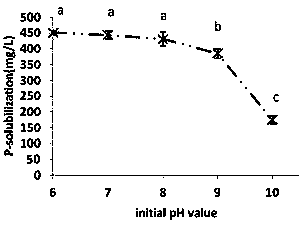Saline-alkaline tolerance phosphorus solublizing bacteria strain and application thereof
A technology of phosphorus-dissolving bacteria and salt-alkali tolerance, applied in the field of microorganisms, can solve problems such as difficult colonization, restrictions on the application of phosphorus-dissolving fungal preparations, poor colonization and phosphorus-dissolving effects, etc., to achieve strong adaptability, improve fertility, and grow good effect
- Summary
- Abstract
- Description
- Claims
- Application Information
AI Technical Summary
Problems solved by technology
Method used
Image
Examples
Embodiment 1
[0058] Example 1 Acquisition of Phosphorus-Solubilizing Bacteria Strain RPB03
[0059] The acquisition process of phosphate-soluble bacterial strain RPB03 is as follows:
[0060] 1) Enrichment culture: collect the rhizosphere soil in the saline-alkali land of the Yellow River Delta, and carry out enrichment culture in the alkaline PKO medium with a pH value of 8.2 until the Ca in the medium 3 (PO 4 ) 2 all degraded;
[0061] 2) Qualitative screening of phosphate-dissolving strains: Dilute the culture solution obtained in step 1) with 8% normal saline, and dilute it with 10-fold concentration gradient dilution method, and select a dilution concentration of 10 8 -10 12 For coating, draw 100 μl of the above dilution with a 200 μl sterile pipette gun, and spread it on an alkaline PKO agar plate with a pH value of 8.2; Continuous 20 generations on the alkaline PKO medium; 17 primary screened strains that still have phosphorus-dissolving effect were obtained, and the primary st...
Embodiment 2
[0066] The further research of embodiment 2 phosphate-dissolving bacterial strain RPB03
[0067] 1. Effects of pH on phosphorus conversion of phosphate-soluble bacterial strain RPB03
[0068] The preserved strain RPB03 was activated, and cultured in liquid medium for 24 hours as a liquid strain. 1ml (10 8 cfu / ml) seed solution was transferred into PKO medium, and the initial pH values of PKO medium were 6, 7, 8, 9 and 10, respectively, and each treatment was repeated three times. The initial pH was adjusted with hydrochloric acid or NaOH solution. After cultivating on a shaking table for 48 hours, centrifuge at 10,000 rpm / min for 15 minutes, and take the sterile filtrate to measure the available phosphorus content. The results are as follows: figure 2 shown.
[0069] Depend on figure 2 It can be seen that with the increase of the initial pH value of the solution, the phosphorus-dissolving ability of the RPB03 strain continued to decrease, and there was a significant d...
Embodiment 3
[0112] Influence of Indigenous Microorganisms on Phosphorus-Solubilizing Bacteria Strain RPB03
[0113] The RPB03 strain was activated on beef extract-peptone medium (beef extract 3.0g, peptone 10.0g, NaCl 5.0g, agar 15-25g, water 1000ml, pH7.4-8.0), cultured at 28-30°C for 36-48h, Then put it into a 1000mL Erlenmeyer flask, and incubate for 36h at 30°C and 170rpm / min. Inoculate 5% by volume into a 50L seed tank. The culture conditions are 170rpm / min, pH8.0, ventilation 0.6vvm, and cultured for 2 days. After the fermentation is completed, centrifuge, precipitate and dry to obtain bacterial powder. Suspended with tap water to make a concentration of 4.1×10 8 cfu / ml bacterial solution.
[0114] Take two equal amounts of saline-alkali soil in the Yellow River Delta, and set up an experimental group and a control group. The control group was sterilized by dry heat sterilization at a temperature of 170°C for 2 hours, and the soil samples in the experimental group were not treat...
PUM
 Login to View More
Login to View More Abstract
Description
Claims
Application Information
 Login to View More
Login to View More - R&D
- Intellectual Property
- Life Sciences
- Materials
- Tech Scout
- Unparalleled Data Quality
- Higher Quality Content
- 60% Fewer Hallucinations
Browse by: Latest US Patents, China's latest patents, Technical Efficacy Thesaurus, Application Domain, Technology Topic, Popular Technical Reports.
© 2025 PatSnap. All rights reserved.Legal|Privacy policy|Modern Slavery Act Transparency Statement|Sitemap|About US| Contact US: help@patsnap.com



